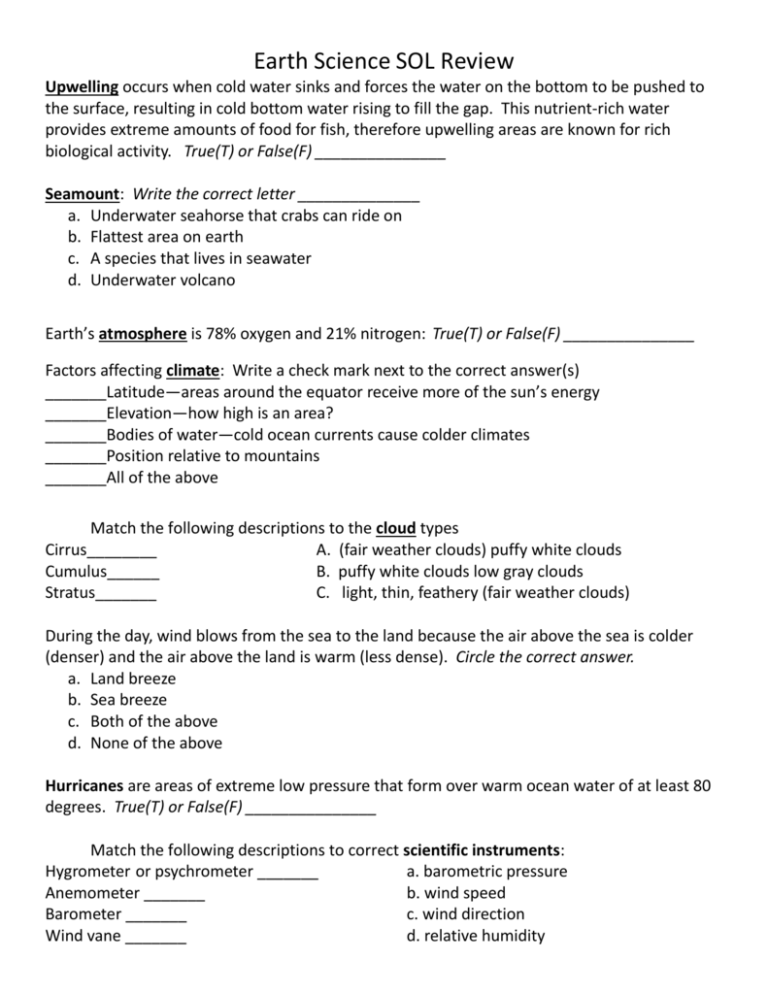SOL Review Questions Based on Earth Science Power Point
advertisement

Earth Science SOL Review Upwelling occurs when cold water sinks and forces the water on the bottom to be pushed to the surface, resulting in cold bottom water rising to fill the gap. This nutrient-rich water provides extreme amounts of food for fish, therefore upwelling areas are known for rich biological activity. True(T) or False(F) _______________ Seamount: Write the correct letter ______________ a. Underwater seahorse that crabs can ride on b. Flattest area on earth c. A species that lives in seawater d. Underwater volcano Earth’s atmosphere is 78% oxygen and 21% nitrogen: True(T) or False(F) _______________ Factors affecting climate: Write a check mark next to the correct answer(s) _______Latitude—areas around the equator receive more of the sun’s energy _______Elevation—how high is an area? _______Bodies of water—cold ocean currents cause colder climates _______Position relative to mountains _______All of the above Match the following descriptions to the cloud types Cirrus________ A. (fair weather clouds) puffy white clouds Cumulus______ B. puffy white clouds low gray clouds Stratus_______ C. light, thin, feathery (fair weather clouds) During the day, wind blows from the sea to the land because the air above the sea is colder (denser) and the air above the land is warm (less dense). Circle the correct answer. a. Land breeze b. Sea breeze c. Both of the above d. None of the above Hurricanes are areas of extreme low pressure that form over warm ocean water of at least 80 degrees. True(T) or False(F) _______________ Match the following descriptions to correct scientific instruments: Hygrometer or psychrometer _______ a. barometric pressure Anemometer _______ b. wind speed Barometer _______ c. wind direction Wind vane _______ d. relative humidity Fill in the correct advantages (a-f), and disadvantages (A-F) Oil Natural gas Coal Nuclear Hydroelectric Wind Solar Advantages _________ _________ _________ _________ _________ _________ _________ Disadvantages ____________ ____________ ____________ ____________ ____________ ____________ ____________ a. b. c. d. e. f. g. Highly efficient; does not cause air pollution; inexpensive Efficient; can be converted into different types of fuel No pollution; clean; renewable Available in US; clean No air pollution; inexpensive; renewable No pollution; clean; inexpensive; renewable Abundant in US; inexpensive A. B. C. D. E. F. G. Causes air pollution and acid rain; mining practices harmful to miners’ health Winds not always constant; not practical for large-scale Difficult to store and transport; mostly nonrenewable Not available in all areas; effects local ecology Causes air pollution; risk of spills while drilling/transporting; nonrenewable Thermal pollution; radioactive waste; nuclear accidents Expensive to convert into usable form Density formula is: Circle the correct answer a. Mass/Volume b. Mass x Volume c. Volume/Mass d. Mass + Volume Match the correct base unit: Length__________ a. gram Mass___________ b. liter Volume_________ c. meter What runs parallel to the equator and is measured North and South? Circle correct answer a. Latitude b. Longitude c. Elevation Match the descriptions to the correct theory Impact theory ________ Dinosaur Extinction Theory _________ Big Bang Theory________ a. The universe originated from the instant expansion of an extremely small agglomeration of matter of extremely high density and temperature. b. The moon formed about 4.5 billion years ago as a result of a collision between Earth and a planet-sized object. c. a giant asteroid hit Earth about 65 million years ago and created atmospheric changes that caused sunlight to be blocked out, altering ecosystems Seasons are caused by: Circle the correct answer a. Distance from the sun to the earth b. Tilt of the earth c. Earth’s Rotation Match the description to the correct type of eclipse Lunar eclipse_______ Solar eclipse________ a. occur when the moon is in Full moon phase the moon passes through Earth’s shadow b. occurs during the day when a new moon is present. The moon blocks the sun Name the 4 inner planets from closest to farthest: ___________________________ ___________________________ ___________________________ ___________________________ Name the 4 outer planets from closest to farthest: ___________________________ ___________________________ ___________________________ ___________________________ Put the correct order of the sun’s life cycle Black Dwarf, Nebula, protostar, red giant, white dwarf, yellow main sequence star 1st _________________________________ 2nd _________________________________ 3rd _________________________________ 4th _________________________________ 5th _________________________________ 6th _________________________________ The Milky Way galaxy where we live is: Circle the correct answer a. elliptical b. irregular c. spiral A light year is the: Circle the correct answer a. distance light travels in one year b. the distance from the sun to the earth c. the distance from the sun to the edge of the solar system Fill in the correct planets Asteroids are found in the asteroid belt, located between the orbits of _________________ and _____________________, and are rocky and made of metals. Write in either True (T) or False(F) Inner core is solid and made of iron and nickel ___________ Outer core is liquid and made of Fe, N, and lighter elements ____________ Mantle is largest layer and is plastic-like ____________ What is the major mechanism of energy transfer in the oceans, atmosphere, and Earth’s interior? Circle the correct answer a. radiation b. conduction c. convection Write in either True (T) or False(F) Ocean crust is less dense than continental crust and it always goes above the continental crust when they collide. Circle the correct answer Dividing plates. Mid-ocean ridges, sea floor spreading, rift valleys, and volcanoes are features of: a. Convergent boundaries b. Divergent boundaries c. Subduction zones d. Transform boundaries Slide past each other. Earthquakes and strike-slip faults are features of e. Convergent boundaries f. Divergent boundaries g. Subduction zones h. Transform boundaries Match the following features to the correct convergent boundaries a. Trenches, volcanic arcs and subduction zones. Ocean plates always go under continental plates. b. Folded mountains, thrust-block mountains c. Trenches, subduction zones, volcanic island arcs C – C ___________________ O – C ___________________ O – O ___________________ Write in either True (T) or False(F) P-waves (compression) travel faster than S-waves _______ S-waves (side to side) will not travel through liquid _______ L-waves are surface waves and cause the most damage_______ How many seismographs are needed to locate an epicenter? a. 1 b. 2 c. 3 d. 4 Fill in the blanks with focus and epicenter The ____________________ is the point on the surface directly above the ______________ where energy is released. 1. 2. 3. 4. 5. Which one is not a property of a mineral? Circle the correct answer Naturally occurring Organic Solid Has a definite (unchanging) chemical composition Has a definite (unchanging) structure Fill in the blanks below: Calcite, Gems, Minerals, Ore, Quartz, Silicates _____________________ are nonrenewable resources. _____________________ are the most abundant mineral group. An ___________________ is a material that is useful and profitable _________________are rare and beautiful. All share extreme hardness as a physical property _________ fizzes with acid and exhibits double refraction. It is the major mineral of limestone. ____________ is the major mineral of glass and sand. Match the correct rock types to the description A rock formed by heat and pressure_________ A rock formed from magma or lava__________ A rock formed by compaction and cementation__________ a. igneous b. metamorphic c. sedimentary Fill in the 2 blanks below a. Coarse-grained texture (large crystals) GRANITE b. Small crystals and fine-grained texture. May look glassy or have holes present. PUMICE, OBSIDIAN, BASALT Which of the above is an intrusive igneous rock? ________ Which of the above is an extrusive igneous rock? ________ Fill in the letter of the correct match associated with metamorphic rocks below Small area in contact with an igneous intrusion “bakes” the rock and changes it. ________ Large area changed due to heat and pressure. Usually with mountains._________ Bands or layers of minerals. SCHIST, SLATE, GNEISS_________ No layers. These rocks have made a complete atomic change. MARBLE, QUARTZITE_________ a. Contact metamorphism b. Foliated texture c. Nonfoliated texture d. Regional metamorphism Fill in the letter of the correct sedimentary rock type match below Made of fragments of other rocks. Conglomerate rounded pebbles; Sandstone—sand; Shale— made of compacted clays ____________ Made from past living sources. Limestone—microscopic sea animals; Coal; fossilized swamp plant material _________ Formed from precipitation or evaporation of liquids. Limestone—cave structures; Halides and Rock Salt; evaporation of water a. Chemical b. Clastic c. Organic Fill in the correct letter below The breakdown and transport of earth materials by wind, water, gravity, glaciers______ The dropping of earth materials after energy of motion of agent of erosion decreases to the point where it cannot carry materials any longer (river)______ Broken down into pieces______ Changed into something chemically different like rust______ a. Chemical weathering c. Mechanical weathering b. Deposition d. Erosion Fill in the correct letter below Amount of pore space in a material. Materials made of rounded particles have a lot of pore space. Materials like clay that are flat and angular have less pore space. The amount of pore space is greater if particles are the same size rather than if mixed sizes are present.____________ The ability of a material to transmit water. Well-sorted (same size and shape) materials are very permeable (GRAVEL and SAND). _______________ Water does not pass through this material—clay packs are very flat, so even though there is pore space, the pores are not connected__________________ a. Impermeable b. Permeability c. Porosity Fill in the correct letter below __________is considered the zone of aeration __________ is one top of the zone of saturation __________layer of rock that stores and transports water freely a. Aquifer b. Soil c. Water table Fill in the correct letter below Fossils can be preserved as _________cavity _________3D replica of organism _________actual animal in ice, amber, or tar pit _________Petrified—material is replaced by minerals _________we date rock layers because these were very abundant, worldwide, and short-lived. a. Casts b. Index Fossils c. Molds d. Original e. Petrified Fill in the correct letter below Carbon-14 dating is used for dating organic material up to 50,000 years old. Uranium—dates the oldest rocks—up to 4.5 billion years Half-life is the amount of time it takes for 50% of a radioactive parent isotope to break down into its stable daughter product a. Carbon-14 dating b. Half-life c. Uranium Circle any incorrect statements: We break down Geologic Time into—Eras (largest division…ends with extinction events), Periods (based on Index Fossils), and Epochs (smallest…based on types of life and is found only in Cenozoic Era) a. Precambrian Era—90% of all geologic history. In the beginning, our planet had no oxygen. Carbon dioxide was the major gas. Cyanobacteria—descendants of blue-green algae-produced oxygen that lead to creation of ozone layer and an atmosphere that supported life b. Paleozoic Era—Age of Invertebrates and the creation of Pangaea c. Mesozoic Era—Age of Reptiles—dinosaurs dominate and Pangaea breaks apart d. Cenozoic Era—Age of Mammals—man comes into existence e. We live in the Cenozoic Era, in the Quaternary Period, in the Recent Epoch








